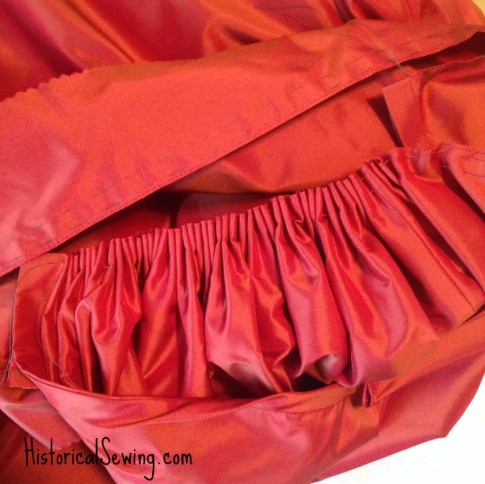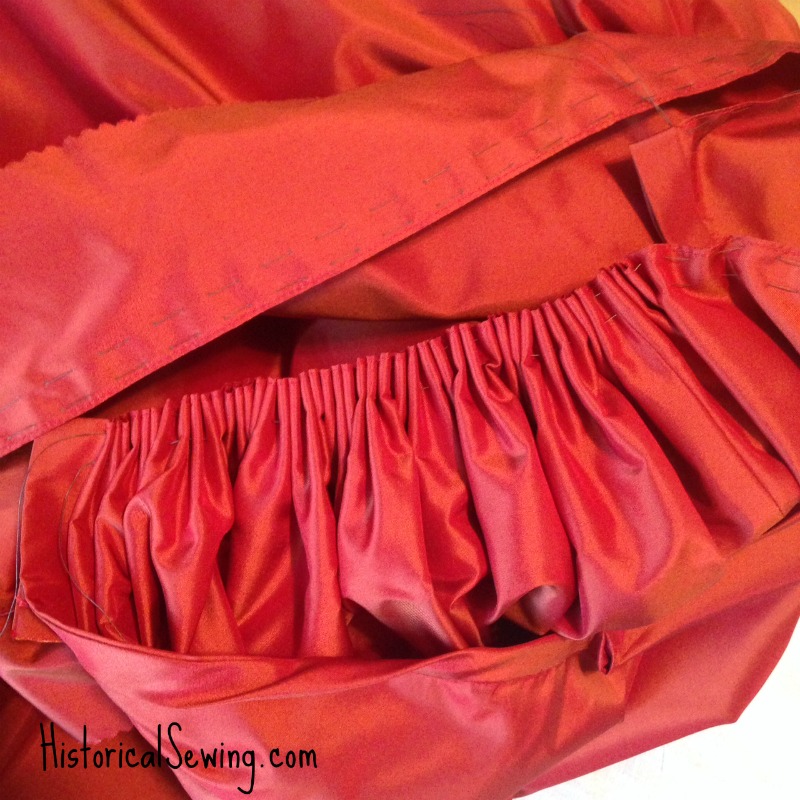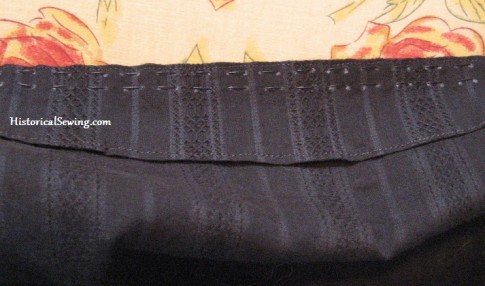
Over the years I’ve seen many, many costumers question and ponder and debate and frustrate themselves over how to calculate cartridge pleats. I get it. It’s pleating. Pleats need to be calculated (or can be, but it’s not absolutely necessary).
But cartridge pleats – or gauging as is the 19th century period term – are a bit different.
Simply, it’s a method of drawing up a long length of fabric to fit a small section (most often setting a skirt onto a waistband). It’s a little like gathering evenly. It’s also like making knife pleats… really uniform and tiny knife pleats!
So if you are trying to produce tiny knife pleats with rows of hand sewn thread lines, why bother doing so much math? It doesn’t have to be that difficult!
The main question I see over and over is, for example: “I have a skirt 165” around and my waistband is 27”. How deep do I make my cartridge pleats?”
I understand where the math thinking is going. I understand the question to divide the skirt by so many equal parts to make it all nice and even. I’m a math person too. I get it.
Let’s not overthink this though.
What if we throw math out the window?! Ack!!
Let’s look at it from how you want your pleats to look (tight or some space between is ok) and also the thickness of your fabric. Keep it simple.
I tend to make nearly all my cartridge pleats the same no matter the fabric. I mark the dots 1/4” apart from each other and 1/4″ width apart of the two rows. I start the top row at 1/8” down from the folded edge. With thicker fabric I’ll open up the rows to 3/8” or even 1/2″ apart.
The further down from the top folded edge you sew the second (and third) rows the longer the controlled pleats will be visually.
The depth of the pleats (the spacing width between dots in the row) is where costumers get caught up in the math stuff.
“If I make my dots 1/4″ apart then each pleat takes up 1/2″ of skirt width and my skirt is 180” then I’ll have 360 pleats then I need to put 90 pleats into each quarter of the waistband, right?”
OR…. “I have a 180” skirt and I want 300 pleats so I need to make each pleat 0.6” so the dots should be 0.3” apart.”
I say: Who cares HOW many pleats you have? Why does the actual number of pleats matter?
Take the skirt and waistband and divide both into quarters (I like to go further with eighths). Mark the skirt with the dot spacing you want. Pin quarter marks together. Pull up pleating threads to fit each section. Fiddle with each section one at a time to spread out and tighten the pleats until it looks good and they are even. Pin in a few places to hold then sew the folds to the waistband. Done.
Why was that so complicated?
(Don’t worry, I will inevitably make it complicated for myself when I go to make my next cartridge pleated skirt…. You’re not alone.)
For varying fabric thicknesses:
If you have a sheer or very thin fabric go with no wider than 1/4″ between dots. Use 1/8” or 3/16” or the 1/4″ width. No real need to use widths other than these.
For medium weight fabric the 1/4″ really does work just fine. You can vary from 3/16” to 3/8” and even 1/2” for deeper pleats (fewer).
For heavy fabric like heavy wool or twill you’ll want deeper pleats as the fabric doesn’t “smash” as much when you pull up a lot of pleats. A 1/2″ dot width is probably the smallest you want to go. A 5/8” width is good. Larger at 3/4″ width will make deep pleats.
Remember that the wider your dots the deeper your cartridge pleat folds which gives you fewer pleats total and will make them more open and less squished together when you go to smooth them out in your quarter sections.
Make a few samples by marking and sewing about a 10” length of your skirt fabric (from the extra stuff not your actual skirt) with your chosen dot width plus one or two other options. Pull each up and see how they look. Decide on the width you like best with your particular fabric.
Keep cartridge pleats simple. And remember not to overthink it all. It’s clothing. 😉



I’m really enjoying cartridge pleating! I am wondering though, what about a gathered bodice? As many others have complained the patterns available don’t give very detailed instruction. How should I go about gathering the bodice? Are cartridge pleats okay for that? Any differences in how they would be done on a bodice?
I haven’t seen cartridge pleating on a bodice before, in my research. I’d recommend regular gathering or stroked gathers, which one can learn in my Hand Stitches class. Stroked gathers are similar to cartridge pleats and probably the technique most used on mid-19th century gathered bodices.
Just cartridge pleated my first skirt today! Your tutorials were indispensable. I didn’t calculate mine either… I put a pin in every 10th pleat, and after measuring the bodice, figured that 10 pleats would take up about 2″. So I was able to stick those pins into the bodice every 2″ and another in between, and sew away.
Yay! Hope it all turned out well.
I’ve reread this several times and finally decided to brave it! Thank you for this, it was super helpful. Pleats maths does my head in. I’ve just finished cartridge pleating a skirt for a robe à l’anglaise, it took me five hours and I can’t feel my fingers. I’ve pleated it as tightly as possible but it’s still 10” too big and I don’t know what to do! Any advice?
Ouch! Is it possible to take out (cut out) a narrow panel of the skirt? That’s not my first choice. How about making a few of the pleats deeper on the inside to take up the excess? I’ve not sewn a robe a l’anglaise (but want to!) so don’t have experience myself with those pleats.
I was hoping there was some way I wouldn’t have to undo the whole thing but oh well! I will try making the pleats deeper, that should do the trick. Thank you for your help!
I want to sew a robe a l’anglaise too… there’s a Georgian Festival in Stamford here in the UK in September and I’m becoming more and more tempted to have my first foray into the 18th century.
It’s funny… the 18th century didn’t appeal to me at all until about six months ago, when I first wore a simple robe a l’anglaise that would have been worn by a Quaker woman in the 1770s, as part of a voluntary project I’ve been doing with a local museum. I think it’s partly that I learnt through this project that the 18th century was more than just extravagance, autocracy and slavery, which are the associations I had with it until fairly recently… and also that I saw that 18th-century fashions weren’t all ridiculously over the top, at least no more than those of any other recent century in Western history.
The 1840s is also on my hit list, so your cartridge-pleating tips will come in use in any case, Jennifer!
Cat, I hope your robe a l’anglaise worked out in the end and that your fingers recovered. 🙂
This is my fear with cartridge pleating! I’m a very beginning sewer and I figured a cartridge pleated skirt would let me practice some hand sewing as well as straight lines on a machine, but… I don’t know how long to make the skirt piece so that my 1/4″ pleats won’t end up either way too short or too long. I’m not worried about anything being exactly math-ey, just worried that I’m so inexperienced it ultimately won’t fit.
Great Article. This math thing is exactly my problem with cartridge pleats. I need to just let it go! 🙂
The easiest way to mark gauged pleats is to use quilters tiger tape. I do a lot of this kind of pleating and tiger tape is indispensable. The Daughters of Charity gauged their aprons and told me they used graph paper so that’s another option. For thread, I use heavy thread like carpet or buttonhole Fred.
Tiger Tape is highly recommended. I know many who use it much delight and ease. I’ve only used it once or twice and found it awkward – for me and my skills at least. More power for those who can use it well!
Yes!! Tiger tape is no-brainer!! Used it many times with awesome looking results.
I’m so glad you posted this! I’ve been saying this for YEARS!!!! LOL! I don’t even mark my pleats anymore… Just eyeball them. It really is “close enough”… And… I sew mine to the waistband ON THE SEWING MACHINE!!! Yep! You read that right!!! As long as you can squash it under the pressure foot, it works like a champ…! You do have to sew slowly, but it’s still faster than hand sewing… 😊
I always use buttonhole thread for cartridge pleating unless the fabric is very thin. Never has a gathering thread broken, even when pleating heavy velvets. Unless there is historical president to do otherwise i tend to make the pleats less deep at the front and deeper at the back , which places the bulk of the fabric over the hips and backside. With very firm fabric it almost creates its own bumroll.
What kind of thread do you use for cartridge pleating? I attempted to gauge a skirt once and was so frustrated with the tread breaking and knotting that I gave up and just knife-pleated it instead!
I use a polished cotton either the hand quilting kind or from my millinery stash.
Run your thread over beeswax a few times. It makes it more slick and protects it from the friction. It’s what was done historically.
I iron smoking dots to the inside of the fabric. In one dot, out the next. Easy! And fast.